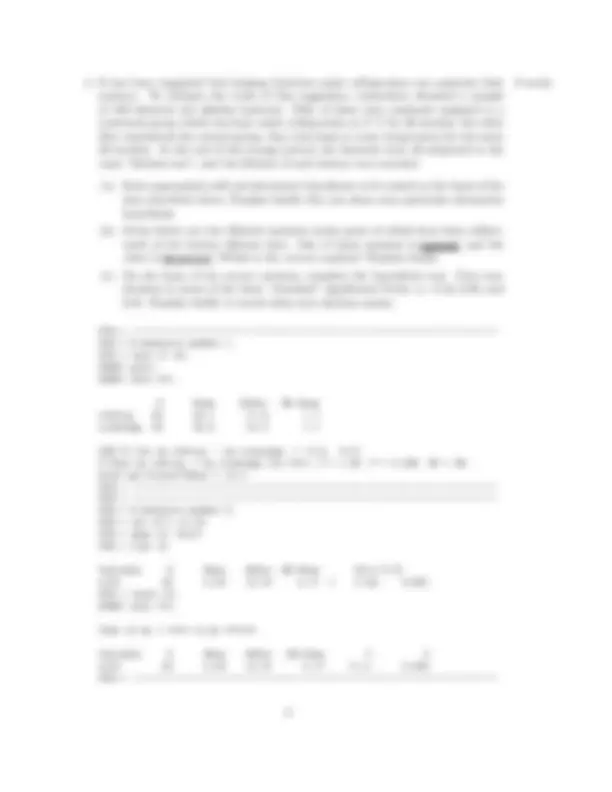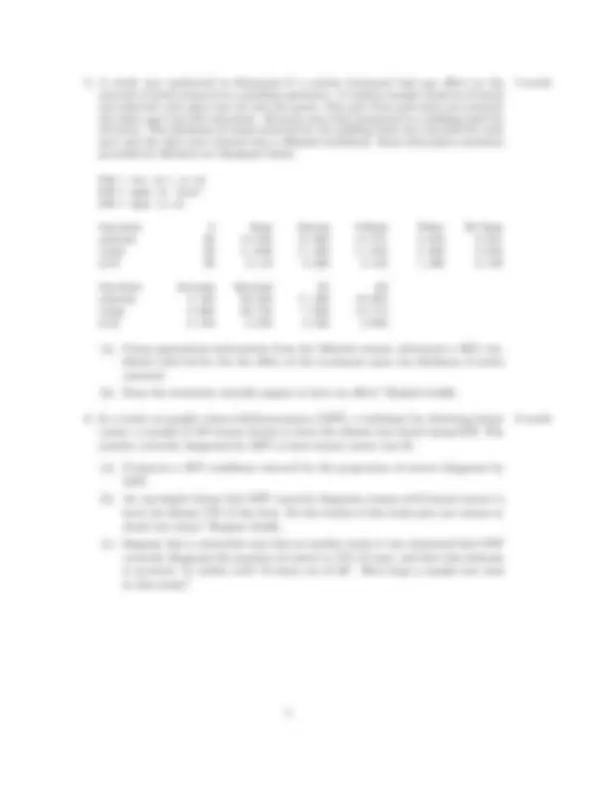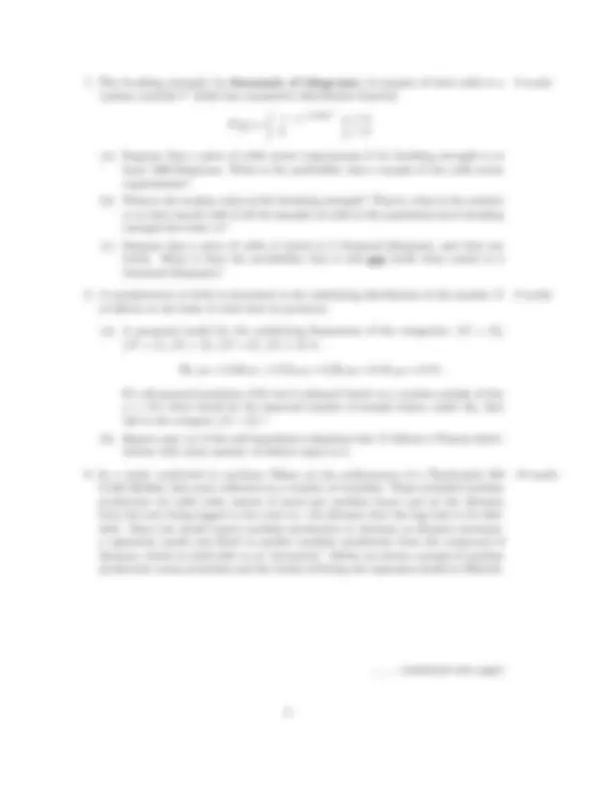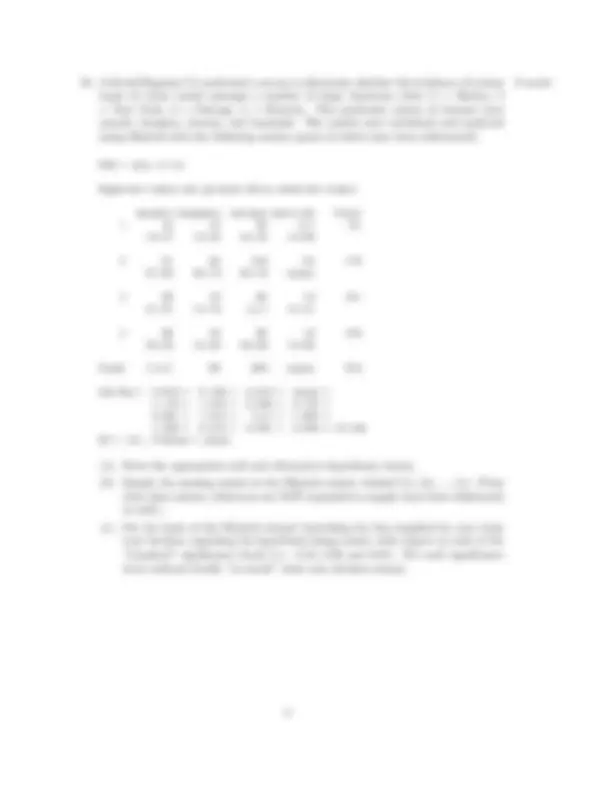






Study with the several resources on Docsity

Earn points by helping other students or get them with a premium plan


Prepare for your exams
Study with the several resources on Docsity

Earn points to download
Earn points by helping other students or get them with a premium plan
Community
Ask the community for help and clear up your study doubts
Discover the best universities in your country according to Docsity users
Free resources
Download our free guides on studying techniques, anxiety management strategies, and thesis advice from Docsity tutors
Information on the probability of micro-cracks detection in metal parts using an x-ray device and digital image processing. It also includes a study on the breaking strength of steel cables and the expected number of defects in bolts of cloth based on poisson distribution. Minitab analyses and calculations.
Typology: Exams
1 / 8

This page cannot be seen from the preview
Don't miss anything!





TIME: 3 hours. Total marks: 100.
SHOW ALL WORK!
(a) What is the value of P (C ∩ D)? That is, what is the probability that a part has micro-cracks and the automatic detection system indicates that it has micro- cracks? (b) What is the value of P (C′^ ∩ D)? That is, what is the probability that a part has no micro-cracks and the automatic detection system (incorrectly) indicates that it has micro-cracks? (c) What is the value of P (D)? That is, what is the probability that the automatic detection system indicates that a part has micro-cracks? (d) Are the events C and D independent? Are they mutually exclusive? Explain briefly. (e) Suppose that the automatic detection system indicates that a part has micro- cracks. What is the probability that it does indeed have micro-cracks?
(a) Suppose that a random sample of 8 trees is chosen. Evaluate the probability that at least 2 of these trees are infested with spruce budworm. (b) Suppose that a random sample of 80 trees is chosen. Evaluate the probability that at least 20 of these trees are infested with spruce budworm.
MTB > print c
f.count 2 2 0 3 1 0 2 0 4 0 0 2 2 1 2 0 2 0 0 2 1 2 1 2 1 1 2 1 0 1
MTB > sum c
Sum of f.count = 37.
(a) Assuming the process to have been in control while these 30 samples were taken, use these results to construct an appropriate (3 SD) control chart. That is, determine the centre line and the upper and lower 3 SD control limits; you need not actually draw a chart. (b) Suppose that a sample of 25 pouches was taken at one of the regular sampling times. How many “fails” would there have to be in the sample to indicate that the process was out of control? (c) The Purple Dwarf company has a similar procedure with their frozen food pouches; they take samples of 20 pouches at regular intervals. Their control chart has a centre line at 0.07 with the UCL equal to 0.24, and LCL equal to 0. Suppose that the Purple Dwarf production process goes out of control in that the fraction of faulty pouches increases to 0.20. What is the probability that the next sample taken will indicate that the process is out of control? (Hint: You can save yourself a lot of tedious arithmetic by using the Binomial tables, Table A.1, pages 700 — 702 Devore, 4th ed., pages 670 — 671 Devore, 3rd ed.) (d) Yet another company (“Eye Gee Eh?”) has a similar procedure. At time t 0 their process shifts to a new state in such a manner that the probability that a sample will signal that a shift has occurred is 0.4. (i) What is the probability that process shift will remain undetected for the first 4 samples taken after time t 0? (ii) How many samples do you expect to be taken after time t 0 before the problem is detected?
MTB > let c3 = c1-c MTB > name c3 ’diff’ MTB > desc c1-c
Variable N Mean Median TrMean StDev SE Mean untreat 38 14.945 14.850 14.721 5.679 0. treat 38 11.826 11.950 11.624 5.826 0. diff 38 3.118 3.200 3.150 1.008 0.
Variable Minimum Maximum Q1 Q untreat 4.100 29.400 11.300 18. treat 0.800 26.700 7.625 15. diff 0.100 5.200 2.525 3.
(a) Using appropriate information from the Minitab output, determine a 90% con- fidence interval for the the effect of the treatment upon the thickness of metal removed. (b) Does the treatment actually appear to have an effect? Explain briefly.
(a) Construct a 95% confidence interval for the proportion of correct diagnoses by GST. (b) An oncologist claims that GST correctly diagnoses women with breast cancer to have the disease 75% of the time. Do the results of the study give you reason to doubt her claim? Explain briefly. (c) Suppose that a researcher says that in another study it was estimated that GST correctly diagnoses the presence of cancer in 74% of cases, and that this estimate is accurate “to within ±4% 19 times out of 20”. How large a sample was used in this study?
F (y) =
1 − e−^0.^05 y 2 y ≥ 0 0 y < 0
(a) Suppose that a piece of cable meets requirements if its breaking strength is at least 1200 kilograms. What is the probability that a sample of the cable meets requirements? (b) What is the median value of the breaking strength? That is, what is the number m so that exactly half of all the samples of cable in the population have breaking strength less than m? (c) Suppose that a piece of cable is tested at 2 thousand kilograms, and does not break. What is then the probability that it will not break when tested at 3 thousand kilograms?
(a) A proposed model for the underlying frequencies of the categories: {X = 0}, {X = 1}, {X = 2}, {X = 3}, {X ≥ 4 } is:
H 0 : p 0 = 0. 30 , p 1 = 0. 25 , p 2 = 0. 20 , p 3 = 0. 10 , p 4 = 0. 15.
If a chi-squared goodness of fit test is planned based on a random sample of size n = 175, what would be the expected number of sample values, under H 0 , that fall in the category {X = 3}? (b) Repeat part (a) if the null hypothesis stipulates that X follows a Poisson distri- bution with mean number of defects equal to 2.
Analysis of Variance
Source DF SS MS F P Regression 1 611.50 611.50 21.96 0. Residual Error 37 1030.29 27. Total 38 1641.
Predicted Values
Fit StDev Fit 90.0% CI 90.0% PI 26.747 0.886 ( 25.252, 28.241) ( 17.720, 35.774) 28.770 1.096 ( 26.921, 30.618) ( 19.677, 37.862) ****** 1.410 ( ******, ******) ( ******, ******)
(a) Test the hypothesis that the slope of the regression line is 0.75 (against a two- sided alternative). Give your conclusions at the “standard” significance levels, i.e. 0.10, 0.05, 0.01. (b) Determine the fitted values of machine production when the proximity is (i) 6, and (ii) 15. Plot the two corresponding points on the Minitab graph, and hence draw the fitted regression line. (c) Find a 90% prediction interval for machine production when the proximity is 12. (d) A professor of Forestry says that when the proximity is 8, the mean machine production is 26. Do the data give you any reason to doubt his assertion? Explain briefly. (e) A Forestry student says that when she was working a summer job, a machine production of 39 was achieved at a site whose proximity was 10. Should you believe her? Explain briefly. (f) One point in particular on the graph of machine production versus proximity stands out as being an outlier. Circle this point. If this point were removed from the data set, and the regression line were re-estimated, which of the following would occur: (i) both the slope and intercept would increase, (ii) both the slope and intercept would decrease, (iii) the slope would increase and the intercept would decrease, (iv) the slope would decrease and the intercept would increase? Explain briefly.
MTB > chis c1-c
Expected counts are printed below observed counts
assault burglary larceny homicide Total 1 16 12 45 (i) 91 19.47 13.30 44.34 13.
2 31 20 100 25 176 37.66 25.73 85.76 xxxxx
3 26 19 46 10 101 21.61 14.76 (ii) 15.
4 28 18 39 19 104 22.25 15.20 50.68 15.
Total (iii) 69 230 xxxxx 472
Chi-Sq = 0.619 + 0.128 + 0.010 + xxxxx + 1.178 + 1.276 + 2.364 + 0.127 + 0.891 + 1.215 + (iv) + 1.897 + 1.483 + 0.514 + 2.691 + 0.620 = 16. DF = (v), P-Value = xxxxx
(a) State the appropriate null and alternative hypotheses clearly. (b) Supply the missing entries in the Minitab output, labeled (i), (ii), ..., (v). (Note that other entries, which you are NOT requested to supply, have been obliterated as well.) (c) On the basis of the Minitab output (including the bits supplied by you) state your decision regarding the hypothesis being tested, with respect to each of the “standard” significance levels (i.e. 0.10, 0.05 and 0.01). For each significance level, indicate briefly “in words” what your decision means.